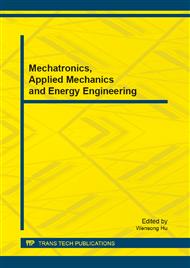[1]
B. Gaines: Linear and Nonlinear Models of the Human Controller (International Journal of Man-Machine Studies, pp.333-360, 1969).
DOI: 10.1016/s0020-7373(69)80001-5
Google Scholar
[2]
D. Kleinman, T. Perkins: Modeling Human Performance in a Time-Varying Anti-Aircraft Tracking Loop (IEEE Transactions on Automatic Control, pp.297-306, 1974).
DOI: 10.1109/tac.1974.1100601
Google Scholar
[3]
M. Kawato: Internal models for motor control and trajectory planning (Current Opinion in Neurobiology, 9, p.718–727, Elsevier, 1999).
DOI: 10.1016/s0959-4388(99)00028-8
Google Scholar
[4]
K. Kurihara, S. Suzuki, F. Harashima, K. Furuta: Human adaptive mechatronics (HAM) for haptic system (30th Annual Conference of IEEE, volume 1, pp.647-652, Busan, South Korea 2004).
DOI: 10.1109/iecon.2004.1433386
Google Scholar
[5]
T. Sasaki, A. Takeya, H. Igarashi, S. Suzuki: Operation Skill Quantification for Mobile Vehicle Operation (SICE Annual Conference, pp.274-279, Takamatsu 2007).
DOI: 10.1109/sice.2007.4420990
Google Scholar
[6]
S. Suzuki, F. Harashima: Analysis of Machine Operation Skills using Hand Discrete Movement (International Conference on Control, Automation and Systems, pp.2824-2829, Seoul 2008).
DOI: 10.1109/iccas.2008.4694240
Google Scholar
[7]
S. Suzuki: Human Adaptive Mechatronics Skill Acquisition in Machine manipulation (IEEE Industrial Electronics Magazine, pp.28-35, 2010).
Google Scholar
[8]
G. K. Tervo, H. Koivo: Towards human skill adaptive manual control (Int J Advanced Mechatronic Systems, volume 2, n. º 1/2, pp.46-58, 2010).
DOI: 10.1504/ijamechs.2010.030848
Google Scholar
[9]
T. Sadahiro, M. Hamazaki, F. Miyawaki, K. Yoshimitsu, K. Masamune: Laparoscopic skill measurement with COP to realize a HAM Scrub Nurse Robot system (Proc of the IEEE International Conference on Systems, Man and Cybernetics, pp.2983-2988.
DOI: 10.1109/icsmc.2007.4413969
Google Scholar
[10]
K. Tervo, M. Bocca, L. M. Eriksson, A. Manninen: Wireless manual control for human adaptive mechatronics (Int J Advanced Mechatronic Systems, volume 2, n. º 4, pp.254-270, 2010).
DOI: 10.1504/ijamechs.2010.033611
Google Scholar
[11]
M. J. McGuffin and R. Balakrishnan: Fitts' law and expanding targets: Experimental studies and designs for user interfaces (Trans Comput Human Interact, volume 12, n. º 4, pp.388-422, 2005).
DOI: 10.1145/1121112.1121115
Google Scholar
[12]
O. Celik, S. Ertugrul: Predictive human operator model to be utilized as a controller using linear, neuro-fuzzy and fuzzy-ARX modeling techniques (Engineering Applications of Artificial Intelligence, 23, pp.595-603, Elsevier, 2010).
DOI: 10.1016/j.engappai.2009.08.007
Google Scholar
[13]
L. Palmroth, A. Putkonen: Work cycle recognition in human operated machines using hidden Markov models (Proc of the 8th International Conference on Motion and Vibration Control, pp.459-464. Daejeon 2006).
Google Scholar
[14]
O. Haavistom, A. Remes: Data-Based Skill Evaluation of Human Operators in Process Industry (International Conference on Control, Automation and Systems, KINTEX, pp.707-712, Gyeonggi-do, South Korea 2010).
Google Scholar
[15]
R. Antunes, F. V. Coito, H. Duarte-Ramos: Improving Operator Performance through the Use of a Multivariable Human-Machine Control Strategy (Technological Innovation for Value Creation, Springer, pp.95-104, 2012).
DOI: 10.1007/978-3-642-28255-3_11
Google Scholar
[16]
R. Antunes, F. V. Coito, H. Duarte-Ramos: A Multi-Variable Modeling Approach for Improving Operator Proficiency (International Journal of Mathematical Models and Methods in Applied Sciences, volume 7, issue 3, pp.238-246, 2013).
Google Scholar
[17]
T Parthornratt, R. M. Parkin, M. Jackson: Human Performance Index (HPI) – A generic performance indicator (Proc of the Institution of Mechanical Engineers, Part I: Journal of Systems and Control Engineering September, volume 225, pp.721-734.
DOI: 10.1177/0959651811407598
Google Scholar
[18]
P. M. Fitts: The Information Capacity of the Human Motor System in Controlling the Amplitude of Movement (Journal of Experimental Psychology: General, volume 121, n. º 3, pp.262-269, 1992).
DOI: 10.1037/0096-3445.121.3.262
Google Scholar
[19]
I. MacKenzie, W. Buxton: Extending Fitts' law to two-dimensional tasks (Proc of the ACM Conference on Human Factors in Computing Systems, pp.219-226, 1992).
DOI: 10.1145/142750.142794
Google Scholar


